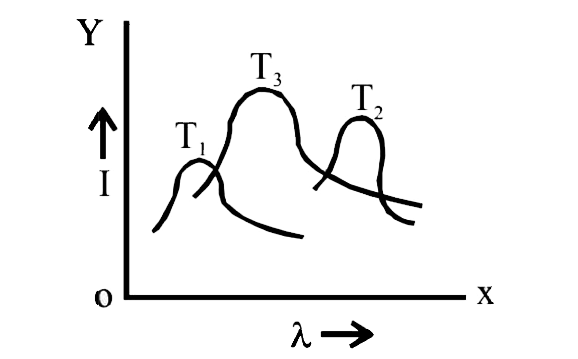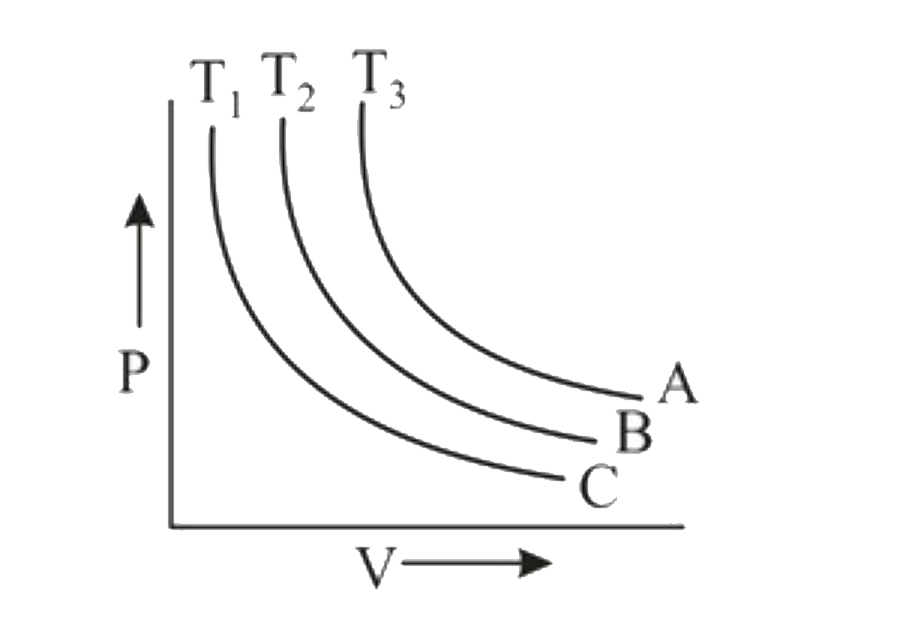Two identical objects A and B are at temperatures TA and TB. Respectively. Both objects are placed in a room with perfectly absorbing walls maintained at a temperature T(TA>T>TB). The objects A and B attain the temperature T eventually. Select the correct statements from the following:
A only emits radiation while B only obsorbs it until both attain the temperature T
A loses more heat by radiation than it absorbs, while B absorbs more radiation than it emits, until they attain the temperature T
Both A and B only absorb radiation, but do not emit it, until they attain the temperature T
Each object continuous to emit and absorb radiation even after attaining the temperature T.
The correct Answer is:B, D
To solve the problem, we need to analyze the situation involving two identical objects A and B at different temperatures, placed in a room with perfectly absorbing walls at a constant temperature T.
1. Identify the Initial Conditions:
- Object A is at temperature TA (where TA>T).
- Object B is at temperature TB (where TB<T).
- The room is maintained at temperature T.
2. Understand Heat Transfer:
- Heat transfer occurs due to temperature differences. Heat flows from a higher temperature to a lower temperature.
- Since TA>T, object A will emit radiation (lose heat) to the surroundings.
- Since TB<T, object B will absorb radiation (gain heat) from the surroundings.
3. Behavior of Object A:
- Object A continuously emits radiation until it reaches temperature T.
- During this process, it loses more heat than it gains because it is at a higher temperature than T.
4. Behavior of Object B:
- Object B continuously absorbs radiation until it reaches temperature T.
- It gains more heat than it emits because it is at a lower temperature than T.
5. Equilibrium Condition:
- Both objects will eventually reach the temperature T. At this point, they will be in thermal equilibrium with the room.
- However, even at thermal equilibrium, both objects will still emit and absorb radiation. This is because thermal equilibrium is dynamic; while the net heat exchange is zero, energy is still being exchanged in equal amounts.
6. Conclusion:
- The correct statements based on the analysis are:
- A only emits radiation while B only absorbs until they reach temperature T.
- A loses more heat by radiation than it absorbs.
- B absorbs more radiation than it emits.
- Even after reaching temperature T, both objects continue to emit and absorb radiation, maintaining dynamic thermal equilibrium.
Final Statements:
- Correct Statements:
1. A only emits radiation while B only absorbs until they both attain temperature T.
2. A loses more heat by radiation than it absorbs.
3. B absorbs more radiation than it emits.
4. Each object continues to emit and absorb radiation even after attaining temperature T.
- Object A is at temperature TA (where TA>T).
- Object B is at temperature TB (where TB<T).
- The room is maintained at temperature T.
- Heat transfer occurs due to temperature differences. Heat flows from a higher temperature to a lower temperature.
- Since TA>T, object A will emit radiation (lose heat) to the surroundings.
- Since TB<T, object B will absorb radiation (gain heat) from the surroundings.
- Object A continuously emits radiation until it reaches temperature T.
- During this process, it loses more heat than it gains because it is at a higher temperature than T.
- Object B continuously absorbs radiation until it reaches temperature T.
- It gains more heat than it emits because it is at a lower temperature than T.
- Both objects will eventually reach the temperature T. At this point, they will be in thermal equilibrium with the room.
- However, even at thermal equilibrium, both objects will still emit and absorb radiation. This is because thermal equilibrium is dynamic; while the net heat exchange is zero, energy is still being exchanged in equal amounts.
- The correct statements based on the analysis are:
- A only emits radiation while B only absorbs until they reach temperature T.
- A loses more heat by radiation than it absorbs.
- B absorbs more radiation than it emits.
- Even after reaching temperature T, both objects continue to emit and absorb radiation, maintaining dynamic thermal equilibrium.
- Correct Statements:
1. A only emits radiation while B only absorbs until they both attain temperature T.
2. A loses more heat by radiation than it absorbs.
3. B absorbs more radiation than it emits.
4. Each object continues to emit and absorb radiation even after attaining temperature T.
Topper's Solved these Questions
- CALORIMETRYBOOK - CENGAGE PHYSICS ENGLISHCHAPTER - CALORIMETRYEXERCISE - Comprehension
30 Videos
- CALORIMETRYBOOK - CENGAGE PHYSICS ENGLISHCHAPTER - CALORIMETRYEXERCISE - Integer
8 Videos
- CALORIMETRYBOOK - CENGAGE PHYSICS ENGLISHCHAPTER - CALORIMETRYEXERCISE - Single Correct
148 Videos
- BASIC MATHEMATICSBOOK - CENGAGE PHYSICS ENGLISHCHAPTER - BASIC MATHEMATICSEXERCISE - Exercise 2.6
20 Videos
- CENTRE OF MASSBOOK - CENGAGE PHYSICS ENGLISHCHAPTER - CENTRE OF MASSEXERCISE - INTEGER_TYPE
1 Videos
Similar Questions
Knowledge Check
For a given exothermic reaction ,KPandKp' are the equilibrium constant at temperature T1andT2 respectively .Assuming that heat of reaction is constant in temperature range between T1andT2 , it is readly observed that
AKp>KpBKp<KpCKp=KpDKp=1Kp'
Two identical objects A and B (emissivity eA and eB,eA≠eB) are planced in an enclosure, Temperature of body A, B and enclosure are same and constant.
View SolutionFrom the following statements concerning ideal gas at any given temperature T, select the correct one (s)
View SolutionFrom the following statements concerning ideal gas at any given temperature T, select the correct one (s)
View SolutionHeat energy at constant rate is given to two substances P and Q. If variation of temperature (T) of substances with time (t) is as shown in figure, then select the correct statement
View SolutionThe plots of intensity versus wavelength for three black bodies at temperature T1,T2andT3 respectively are as shown. Their temperatures are such that

View SolutionTwo Carnot engines A and B are operated in series. The engine A receives heat from the source at temperature T1 and rejects the heat to the sink at temperature T. The second engine B receives the heat at temperature T and rejects to its sink at temperature T2. For what value of T the efficiencies of the two engines are equal?
View SolutionTwo objects A and B are moving in opposite directions with velocities vAandvB respectively, the magnitude of relative velocity of A w.r.t. B is
View Solution

